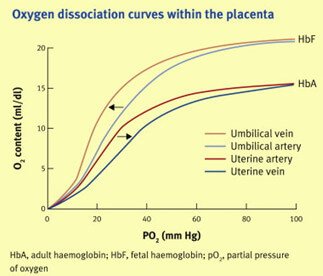Bohr Effect and Haldane Effect
Definition of Bohr Effect
A physiological phenomenon in which changes in carbon dioxide and hydrogen ion concentration are brought about due to shift in the Oxygen-Hemoglobin dissociation curve is called Bohr Effect.
Functions of Hemoglobin
Hemoglobin, a conjugated protein consisting of heme and globin which is found in red blood cells (erythrocytes) is responsible for giving red color to our blood. It’s a great source of energy metabolism and also plays a pivotal role in respiration. It interacts with nitric oxide in order to regulate the blood pressure. In addition, it also acts as an anti-oxidant and regulates metabolism of iron in macrophages, alveolar cells and mesangial cells in kidney but above everything else, it carries carbon dioxide from the body tissues to the lungs and oxygen from the lungs to the body tissues.
What is Double Bohr Effect
When the Bohr Shift operates in one direction in the maternal blood and in other direction in the fetal blood, this phenomenon is called double Bohr Effect.
What is Reverse Bohr Effect
The affinity of hemocyanin (A metallo-respiratory protein) towards oxygen due to decrease in PH in certain invertebrates leads to the occurrence of an effect in which accumulation of lactate in the blood is established. This effect is called Reserve Bohr Effect.
Graphical Representation

Picture 1: Oxy-Hemoglobin Dissociation Curve. Dotted red line corresponds with shift to the right caused by Bohr Effect.
Source: Wikipedia
————————————————————————————————————-
Definition of Haldane Effect
Increase in the concentration of carbon dioxide will displace oxygen from hemoglobin and binding of Oxygen with Hemoglobin in turn will displace Carbon dioxide from blood. This phenomenon is referred to as the Haldane Effect.
What is Double Haldane Effect?
Mostly Prominent in the Intra-uterine life, the Haldine Effect takes places in the utero-placental circulation in which the affinity of fetal carbon dioxide decreases and uptake of maternal carbon dioxide is enhanced. As the intake of oxygen by foetal blood takes place, the release of carbon dioxide becomes more likely. The double Haldane effect accounts for approximately 46% of the Trans-placental carbon dioxide transfer.
Graphical Representation

Picture 1: Oxygen Dissociation Curves within the placenta indicating Double Haldane Effect
——————————————————————————————————————————-
Bohr Effect Vs Haldane Effect
In Bohr Effect, binding of Oxygen to hemoglobin in lungs takes place (because carbon dioxide concentration is less in lung alveoli) which results in leftward shift of Oxy-hemoglobin Dissociation Curve. In contrast to it, release of oxygen from hemoglobin in body tissues (due to increased amount of carbon dioxide) will cause rightward shift of the curve.
The Haldane effect, on the other hand describes how oxygen concentration can determine hemoglobin’s affinity towards carbon dioxide.
Published by Dr. Raj MD under Medical Physiology.
Article was last reviewed on August 6th, 2018.

